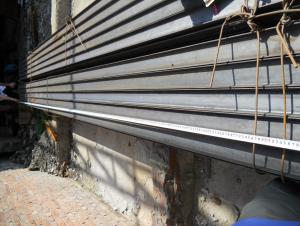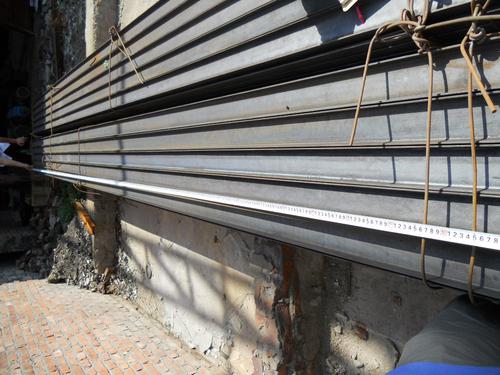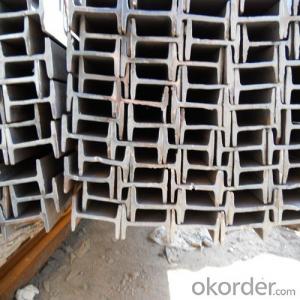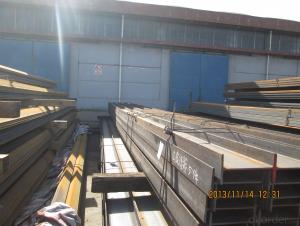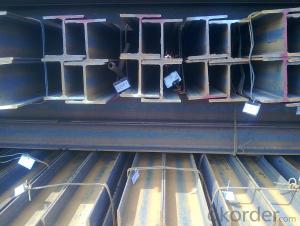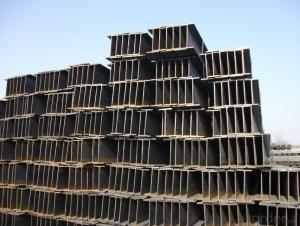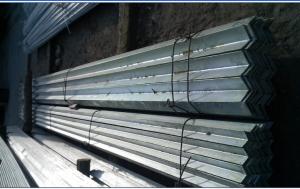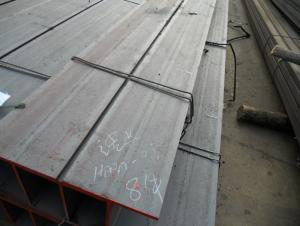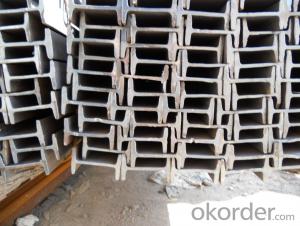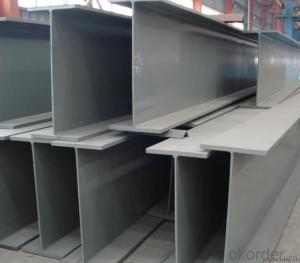HR Steel I Beams
- Loading Port:
- Tianjin
- Payment Terms:
- TT OR LC
- Min Order Qty:
- -
- Supply Capability:
- 200000 m.t./month
OKorder Service Pledge
OKorder Financial Service
You Might Also Like
Specifications of I-Beam Steel
Product name: I-Beam Steel
Production Standard: GB, BS, ASTM, EN, DIN, JIS
Grade: Q235B, Q345B, ASTM A36, SS400, S235JR, S275JR
Chemical composition
Alloy No. | Grade | C | Mn | S | P | Si |
Q235 | B | 0.12%-0.20% | 0.3%-0.7% | <=0.045% | <=0.045% | <=0.3% |
Length: 5.8M, 6M, 8M, 9M, 10M, 12M or as the requirements of the buyer
Sizes: 80MM-270MM
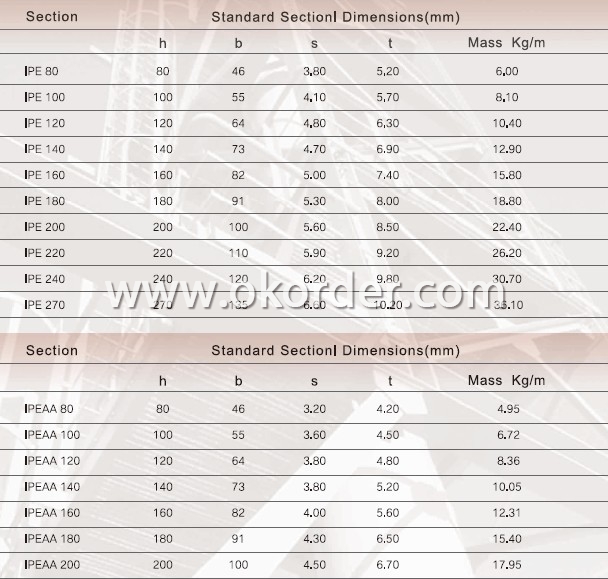
Applications of I-Beam Steel
Widely used in various building structures and engineering structures such as roof beams, bridges, transmission towers, hoisting machinery and transport machinery, ships, industrial furnaces, reaction tower, container frame and warehouse etc.
Package and Delivery
1. Package: All the products will be tired by wire rod in bundles and then put into containers 20', 40' or in bulk cargo.
Or according the requirements of the customers. Each bundle will be hung a CNBM label, which will include the information of our trademark, size, material, lengh, standard, etc. Normally, each bundle contain 50 pieces.
Bundle weight: not more than 3.5MT for bulk vessel; less than 3 MT for container load
But we can also make the bundles as the requriement of you.
2. Delivery: Within 45 days after getting the L/C ORIGINAL or the advance payment by T/T.

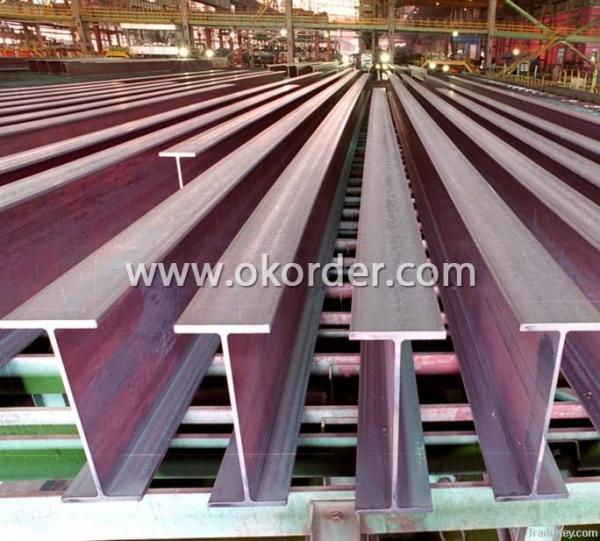
Production flow of I-Beam Steel
Material prepare (billet) —heat up—rough rolling—precision rolling—cooling—packing—storage and transportation
- Q: How do steel H-beams contribute to water conservation in buildings?
- Water conservation in buildings is greatly aided by the use of steel H-beams, as they enable the incorporation of sustainable design features like rainwater harvesting systems and efficient plumbing systems. To begin with, the construction of roofs often involves the utilization of steel H-beams, which are ideal for the installation of rainwater harvesting systems. These systems gather and store rainwater that can be utilized for various non-potable purposes, including toilet flushing, irrigation, and cooling. By utilizing rainwater instead of potable water for these tasks, steel H-beams indirectly aid in water conservation by reducing the demand for fresh water. Moreover, steel H-beams are crucial for the construction of water-efficient plumbing systems. These systems can integrate elements such as low-flow fixtures, dual-flush toilets, and sensor-activated faucets. These water-saving fixtures help minimize water consumption by reducing the amount of water used per flush or per use. Steel H-beams provide the necessary structural support to incorporate these sustainable plumbing features into building designs. Furthermore, steel H-beams possess exceptional durability and longevity, thus reducing the need for frequent repairs or replacements. This durability minimizes water wastage caused by leaks or damages to the building structure. By ensuring the stability and integrity of the building, steel H-beams actively contribute to water conservation by preventing water damage and subsequent water loss. To summarize, steel H-beams greatly aid in water conservation within buildings by enabling the installation of rainwater harvesting systems, supporting water-efficient plumbing systems, and providing structural durability to prevent water wastage. By incorporating these sustainable design features, steel H-beams assist in reducing the demand for fresh water and promoting responsible water usage in buildings.
- Q: Can steel H-beams be used for multi-story buildings?
- Yes, steel H-beams can be used for multi-story buildings. H-beams, also known as I-beams, are commonly used in construction because of their strength and load-bearing capabilities. These beams are designed to distribute the weight of the building evenly and provide structural support. Their shape allows for greater stability and resistance to bending or twisting forces. Steel H-beams are commonly used in the construction of multi-story buildings due to their ability to support heavy loads and provide a solid framework. Additionally, steel is a durable material that can withstand various weather conditions, making it a popular choice for high-rise construction.
- Q: What does H steel column H300*250*6*10-90 represent in steel structure?
- H300*250*6*10 indicates that the welded composite H type steel has a web height of 300, web thickness 6, flange width 250, flange thickness 10, and the units are mm.
- Q: How do steel H-beams perform in sports arena construction?
- Steel H-beams are commonly used in sports arena construction due to their excellent structural performance. These beams provide superior strength and load-bearing capabilities, making them ideal for supporting the heavy loads and stresses experienced in sports arenas. Steel H-beams are designed to distribute weight evenly, which helps to evenly distribute loads from the roof, lighting systems, and other equipment in the arena. This ensures the structural integrity of the building and prevents any potential failures or collapses. Furthermore, steel H-beams have high resistance to bending and twisting forces, making them suitable for withstanding the dynamic loads generated by sporting events such as basketball games or concerts. They also have excellent fire resistance, which is crucial for the safety of the spectators and athletes. Additionally, steel H-beams are versatile and can be easily customized to meet the specific design requirements of sports arenas. They can be fabricated into various lengths, sizes, and shapes, allowing architects and engineers to create innovative and aesthetically pleasing structures. Moreover, steel H-beams have a long lifespan and require minimal maintenance, making them a cost-effective choice for sports arena construction. They are also recyclable, which aligns with sustainable construction practices. In summary, steel H-beams are essential components in sports arena construction due to their exceptional strength, load-bearing capabilities, resistance to bending and twisting forces, fire resistance, versatility, and long lifespan. These beams ensure the safety and structural integrity of sports arenas, providing a solid foundation for hosting sporting events and other activities.
- Q: Are steel H-beams suitable for seismic design?
- Yes, steel H-beams are suitable for seismic design. They have proven to be a reliable and effective structural element in seismic zones due to their high strength and stiffness. H-beams are capable of resisting lateral forces and vibrations caused by earthquakes, making them a popular choice in seismic design for their ability to provide stability and structural integrity.
- Q: What is the average cost of steel H-beams?
- The average cost of steel H-beams can vary depending on various factors such as size, weight, and quality. Generally, the price range for steel H-beams falls between $500 to $2000 per ton. However, it is important to note that these prices are subject to change due to market fluctuations and individual supplier rates. Additionally, factors such as quantity and location of purchase may also affect the final cost. Therefore, it is recommended to consult with multiple suppliers and compare prices to obtain a more accurate estimate for the average cost of steel H-beams.
- Q: Can steel H-beams be used in school or educational facility construction?
- Yes, steel H-beams can be used in school or educational facility construction. Steel H-beams are commonly used in construction due to their structural strength, durability, and ability to withstand heavy loads. They provide stability and support to the building's framework, making them suitable for constructing large educational facilities. Additionally, steel H-beams offer flexibility in design and can be easily integrated into various architectural styles, allowing for creative and modern educational spaces.
- Q: Are steel H-beams suitable for use in the construction of airports or terminals?
- Yes, steel H-beams are suitable for use in the construction of airports or terminals. They are known for their strength, durability, and ability to withstand heavy loads, making them an ideal choice for supporting large structures such as airport terminals. Additionally, steel H-beams offer flexibility in design, allowing for efficient use of space and customization to specific project requirements.
- Q: Can steel H-beams be used in theaters and auditoriums?
- Indeed, theaters and auditoriums can make use of steel H-beams. These beams are widely employed in construction owing to their impressive strength-to-weight ratio and structural stability. Within theaters and auditoriums, they serve the purpose of supporting the roof, walls, and other structural elements, thereby establishing a robust framework for the building. Moreover, steel H-beams offer versatility as they can be fabricated into various lengths and shapes, enabling customized designs that cater to the specific needs and requirements of the theater or auditorium. By utilizing steel H-beams in these spaces, a safe and durable structure is guaranteed, capable of withstanding heavy loads and providing a sturdy foundation for the artistic performances and activities that transpire within.
- Q: How do steel H-beams perform in terms of seismic resistance?
- Steel H-beams perform exceptionally well in terms of seismic resistance. Their strong and rigid structure allows them to effectively dissipate and absorb seismic energy during earthquakes, minimizing damage to the building. Additionally, steel H-beams are highly ductile, meaning they can deform without fracturing, further enhancing their seismic performance. These factors make steel H-beams a preferred choice for seismic-resistant construction.
Send your message to us
HR Steel I Beams
- Loading Port:
- Tianjin
- Payment Terms:
- TT OR LC
- Min Order Qty:
- -
- Supply Capability:
- 200000 m.t./month
OKorder Service Pledge
OKorder Financial Service
Similar products
Hot products
Hot Searches
Related keywords
